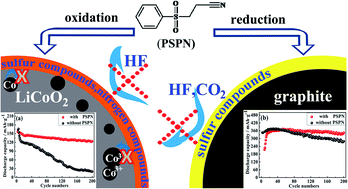3-(Phenylsulfonyl)propionitrile as a higher voltage bifunctional electrolyte additive to improve the performance of lithium-ion batteries
Abstract
The effects of 3-(phenylsulfonyl)propionitrile (PSPN) as a higher voltage bifunctional additive in the electrolyte on the formation of a solid electrolyte interface (SEI) on both LiCoO2 cathodes and graphite anodes are investigated using the half-cell method. The capacity retention of the Li/LiCoO2 and Li/graphite batteries with PSPN ranges from 10.12% and 74.81% to 79.19% and 92.58% after 200 cycles, respectively. The results of linear sweep voltammetry (LSV) and cyclic voltammetry (CV) demonstrate that PSPN is not only preferentially reduced but also easily oxidized during the charge–discharge process. X-ray photoelectron spectroscopy (XPS) and scanning electron microscopy (SEM) analyses confirm that PSPN-containing SEI films can form simultaneously on both electrodes due to the interaction of nitrile (–C![[triple bond, length as m-dash]](https://www.rsc.org/images/entities/char_e002.gif) N) and sulfur–oxygen double bonds (S
N) and sulfur–oxygen double bonds (S![[double bond, length as m-dash]](https://www.rsc.org/images/entities/char_e001.gif) O), providing protection to the LiCoO2 and graphite electrodes and improving the cycle performance at higher voltage.
O), providing protection to the LiCoO2 and graphite electrodes and improving the cycle performance at higher voltage.



 Please wait while we load your content...
Please wait while we load your content...